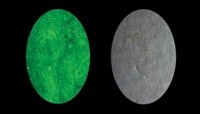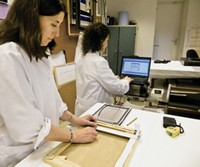Advertisement
Grab your lab coat. Let's get started
Welcome!
Welcome!
Create an account below to get 6 C&EN articles per month, receive newsletters and more - all free.
It seems this is your first time logging in online. Please enter the following information to continue.
As an ACS member you automatically get access to this site. All we need is few more details to create your reading experience.
Not you? Sign in with a different account.
Not you? Sign in with a different account.
ERROR 1
ERROR 1
ERROR 2
ERROR 2
ERROR 2
ERROR 2
ERROR 2
Password and Confirm password must match.
If you have an ACS member number, please enter it here so we can link this account to your membership. (optional)
ERROR 2
ACS values your privacy. By submitting your information, you are gaining access to C&EN and subscribing to our weekly newsletter. We use the information you provide to make your reading experience better, and we will never sell your data to third party members.
Analytical Chemistry
A Laser Blast Helps Cultural Heritage Researchers Study Insoluble Dyes On Artifacts
Analytical Chemistry: New sampling method for surface-enhanced Raman spectroscopy extends the range of materials that can be studied by the technique
by Louisa Dalton
May 21, 2013

To study the composition of fragile, ancient artifacts, scientists often turn to surface-enhanced Raman spectroscopy (SERS), a noninvasive technique that can identify low levels of small organic molecules, such as dyes. But current SERS methods don’t work with some oily or otherwise insoluble materials. Now researchers report a laser vaporization method that allows analysis of previously SERS-incompatible materials (Anal. Chem. 2013, DOI: 10.1021/ac400440c).
In a typical SERS experiment, scientists dissolve their sample in a solution containing gold or silver nanoparticles so that the sample molecules adsorb onto the nanoparticles. When the researchers shine laser light on the particles, the metal surfaces greatly amplify the characteristic signals produced by the excited molecules. Based on these signals, the scientists can identify the compounds and measure their concentrations.
It’s hard to predict how each sample will react with the nanoparticles, says Pablo S. Londero, a cultural heritage scientist at the Metropolitan Museum of Art, in New York City. “You never know what an artist put into a material,” he says.
What’s more, many materials are insoluble or don’t adsorb well to the metal surfaces. For example, Londero and his colleague Marco Leona were studying dyed leather from an ancient Egyptian chariot. The dyes are embedded within the leather’s collagen matrix, so it’s tricky to prepare a sample for a traditional SERS analysis.
The researchers wondered if the solution to their problem was to first vaporize the samples. They knew that a laser pulse can blast a pinpoint of material from a surface into the air without harming or heating the surrounding material, thus protecting the integrity of the artifact during analysis. Also, vaporized material could more readily adsorb to a metal surface, allowing for SERS.
After some fine-tuning of the idea, Londero, Leona, and collaborator John R. Lombardi of The City College of New York came up with a SERS method that takes about 15 minutes.
They slide a sample into a small vacuum chamber mounted under a microscope. After pumping the air out of the chamber, they use the microscope to choose a part of the sample to hit with an intense laser pulse. The laser vaporizes a few micrometers of the targeted material, which deposits onto a thin film of silver nanoparticles attached just above the sample. The scientists then shine another laser on the silver to record the characteristic signals produced by the material.
The scientists tried out their technique on the dyes embedded in the 3,000-year-old Egyptian leather. Based on the clear spectra produced for the sample, the team confirmed that the pigment is madder lake, dye from the madder plant (Rubia) combined with a metal that helps it bind to the leather. Ancient Egyptians were among the first people to create pigment from the madder plant.
The whole setup is quite clever, says Renato Zenobi, an analytical chemist at the Swiss Federal Institute of Technology, Zurich. He likes that the sample vaporizes directly onto the metal surfaces, keeping the whole experiment within one sample holder. But the greatest advantage, he notes, is that the technique produces spectra of completely insoluble materials generally out of reach with typical SERS methods.





Join the conversation
Contact the reporter
Submit a Letter to the Editor for publication
Engage with us on Twitter